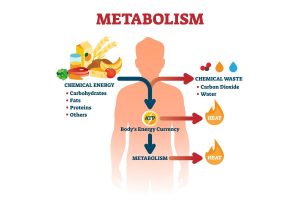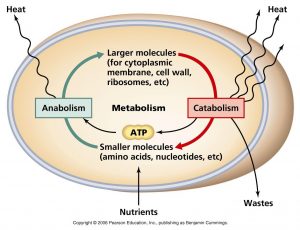Nutrition and life mechanisms
Metabolism studies have revealed the mechanisms that allow cells and organisms to survive, grow and proliferate. Today they can be used to increase longevity and improve health. Even through what we eatOur body grows, lives and reproduces through an infinite series of biochemical reactions perfectly harmonic and functional to our species’ survival. In the course of time, these chemical processes deteriorate with a speed that depends on a series of endogenous and exogenous attacks: if recognized and rebalanced, the organism is able to self-regenerate; if neglected, their side-effects add up and over time they become chronic pathologies causing the end of the individual himself.A portion of this complex pattern of chemical reactions is called Metabolism, that is the set of biochemical processes that governs our body energy system and the production of its fundamental building blocks: proteins, nucleic acids (DNA and RNA), fats and other cellular components.A poorly functioning metabolism has an infinite number of negative impacts on our body and its systems, because it affects both the energy level to make them work as well as their structural components.The production of energy occurs through the transformation of substances ingested with food, which also provides an important contribution to the construction of our cells building blocks, thanks to all those nutrients that our body is not able to self-produce.
Al di là del piacere culinario, l’alimentazione ha un ruolo fondamentale nella sopravvivenza e nello sviluppo del nostro corpo, fornendogli componenti essenziali.
Catabolism and Anabolism
Cell Metabolism is a combination of two processes that alternate: Catabolism and Anabolism. The first is related to the transformation of nutrients into energy, which is measured in ATPAdenosine triphosphate (ATP) can be defined as the "energy currency" of the cell, the instrument through which the cell carries out processes that require energy (endoergonic) and is produced by reactions that release energy (exergonic). units (cellular gasoline); from the latter it depends the trasformation of macro-nutrients into essential cell building blocks and the functioning of our physiological systems.During the catabolic phase, with the help of the oxygen we breathe, our body breaks down food into macronutrients (Lipids, Carbohydrates and Proteins) and releases energy (ATP), thanks to the action of Enzymes, a special group of proteins that accelerate the transformation of macronutrients, activated by our hormonal system (ie. insulinHormone produced by Langerhans island cells of the pancreas. It stimulates the entry of glucose into the cells, subtracting it from the blood and thus lowering blood sugar. It induces the use of glucose both to produce energy and for the synthesis of glycogen and fats.).During the anabolic phase, our body recombines these macronutrients into semi-finished products (amino acidsAmino acids are the basic substances that make up proteins. Each protein is characterized by a precise sequence of amino acid "bricks". Some are produced by the body by processing food, others, which the body cannot synthesize, must be taken directly with food., simple sugars, fatty acids, glycerol) which are then utilized to create larger and more complex structures (macro-molecules) that are essential to the activity of cell proliferation and differentiation and to the functioning of the various systems of our body, leveraging the energy produced during catabolism to make this production process happen. Our hormonal system plays a key role during this phase, in particular the insulin hormone.
the macro-molecules are Proteins, Nucleic Acids (RNA and DNA), Phospholipids and Carbohydrates. All essential components for the functioning and growth of our organism.
The metabolic pathways, one of the inner secrets of our existence
The anabolic phase is divided into 3 cross-interacting micro-processing laboratories devoted to produce all the essential metabolic building blocks.These are commonly called “metabolic pathways”:- The insulin pathway (GH, IGF-1) reacts to complex sugars ingested and convert them into simple sugars and proteins. Its final mission is the “growth of the organism”, promoting cell proliferation and differentiation, through the supply of energy deposits and structural components.
- The mTORThe mTOR (mammalian target of rapamycin) is a set of enzymes (route) that react to food-nutrients, breaking them down and recombining them to build new proteins useful for the "growth of the body". They react to specific hormonal stimuli (Insulin and IGF-1) thus becoming the center of control of growth and cell proliferation in metabolism. This metabolic route is also responsible for the elimination of old and defective cells (Cellular Autophagy) with the double advantage of recycling the fundamental components to produce new cells and eliminate them to prevent them from triggering degenerative and inflammatory processes. (mammalian target of rapamycin) reacts to the proteins ingested with food and reuses them to build new ones useful for the “growth of the organism”, promoting cell proliferation. This pathway is also responsible for the elimination of old and defective cells (Cellular autophagyCellular autophagy or autophagocytosis is a cellular mechanism for selective removal of old or damaged cell components. It allows the degradation and recycling of recovered components to build new proteins. Its proper functioning has substantial impacts on the reduction of low grade inflammation and the onset of chronic and tumor diseases.) with the double advantage of recycling their building blocks to produce new cells and eliminating them to prevent linked degenerative and inflammatory processes.
- AMPKAMPK (AMP-activated protein kinase) stands for monophosphate-activated adenosine protein kinase. It is an enzyme that plays a critical role in cellular homeostasis and a signaller of the body's energy level: it signals whether there is enough in the body to activate cellular functions such as glucose absorption, fat oxidation, and the formation of new mitochondria. In case the energy is not enough, it stops the activity of creation of macro-molecules by pausing the production activity. The AMPK way is a "metabolic regulator". (AMP-activated protein kinase) reacts to the energy level of the body in an inversely proportional way. Since energy is essential to produce macro-molecules for body functioning and its development, this pathway signals if there is enough of it in the body and, if not, it stops the activity of macro-molecules creation by pausing the production activity. The AMPK pathway is a “metabolic regulator”.
The trade-off between body growth and lifespan
The life balance is dominated by the “principle of survival” of the species, that favors all those processes and adaptations of the organism able to guarantee the best outcomes for its survival in a certain environment and under certain conditions.Every living organism therefore has a survival mechanism that, on the one hand, accelerates its growth and proliferation when environmental conditions are favorable; when not, it can interrupt these processes, pausing them, so as to reduce the need to the minimum and wait for better times.
Our life processes are focused on ensuring the species survival, and not the individual across the time. Understanding their mechanisms is the key to living long and healthy lives.





